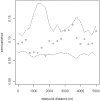Human helminth co-infection: analysis of spatial patterns and risk factors in a Brazilian community
- PMID: 19104658
- PMCID: PMC2602736
- DOI: 10.1371/journal.pntd.0000352
Human helminth co-infection: analysis of spatial patterns and risk factors in a Brazilian community
Abstract
Background: Individuals living in areas endemic for helminths are commonly infected with multiple species. Despite increasing emphasis given to the potential health impacts of polyparasitism, few studies have investigated the relative importance of household and environmental factors on the risk of helminth co-infection. Here, we present an investigation of exposure-related risk factors as sources of heterogeneity in the distribution of co-infection with Necator americanus and Schistosoma mansoni in a region of southeastern Brazil.
Methodology: Cross-sectional parasitological and socio-economic data from a community-based household survey were combined with remotely sensed environmental data using a geographical information system. Geo-statistical methods were used to explore patterns of mono- and co-infection with N. americanus and S. mansoni in the region. Bayesian hierarchical models were then developed to identify risk factors for mono- and co-infection in relation to community-based survey data to assess their roles in explaining observed heterogeneity in mono and co-infection with these two helminth species.
Principal findings: The majority of individuals had N. americanus (71.1%) and/or S. mansoni (50.3%) infection; 41.0% of individuals were co-infected with both helminths. Prevalence of co-infection with these two species varied substantially across the study area, and there was strong evidence of household clustering. Hierarchical multinomial models demonstrated that relative socio-economic status, household crowding, living in the eastern watershed and high Normalized Difference Vegetation Index (NDVI) were significantly associated with N. americanus and S. mansoni co-infection. These risk factors could, however, only account for an estimated 32% of variability between households.
Conclusions: Our results demonstrate that variability in risk of N. americanus and S. mansoni co-infection between households cannot be entirely explained by exposure-related risk factors, emphasizing the possible role of other household factors in the heterogeneous distribution of helminth co-infection. Untangling the relative contribution of intrinsic host factors from household and environmental determinants therefore remains critical to our understanding of helminth epidemiology.
Conflict of interest statement
The authors have declared that no competing interests exist.
Figures



References
-
- Howard SC, Donnelly CA, Kabatereine NB, Ratard RC, Brooker S. Spatial and intensity-dependent variations in associations between multiple species helminth infections. Acta Tropica. 2002;83:141–149. - PubMed
-
- Drake LJ, Bundy DA. Multiple helminth infections in children: impact and control. Parasitology. 2001;122(Suppl):S73–81. - PubMed
-
- Brooker S, Miguel EA, Moulin S, Luoba AI, Bundy DA, et al. Epidemiology of single and multiple species of helminth infections among school children in Busia District, Kenya. East African Medicine Journal. 2000;77:157–161. - PubMed
-
- Chamone M, Marques CA, Atuncar GS, Pereira AL, Pereira LH. Are there interactions between schistosomes and intestinal nematodes? Transactions of the Royal Society of Tropical Medicine and Hygiene. 1990;84:557–558. - PubMed
-
- Booth M, Bundy DA, Albonico M, Chwaya HM, Alawi KS, et al. Associations among multiple geohelminth species infections in schoolchildren from Pemba Island. Parasitology. 1998;116 (Pt 1):85–93. - PubMed
Publication types
MeSH terms
Grants and funding
LinkOut - more resources
Full Text Sources

